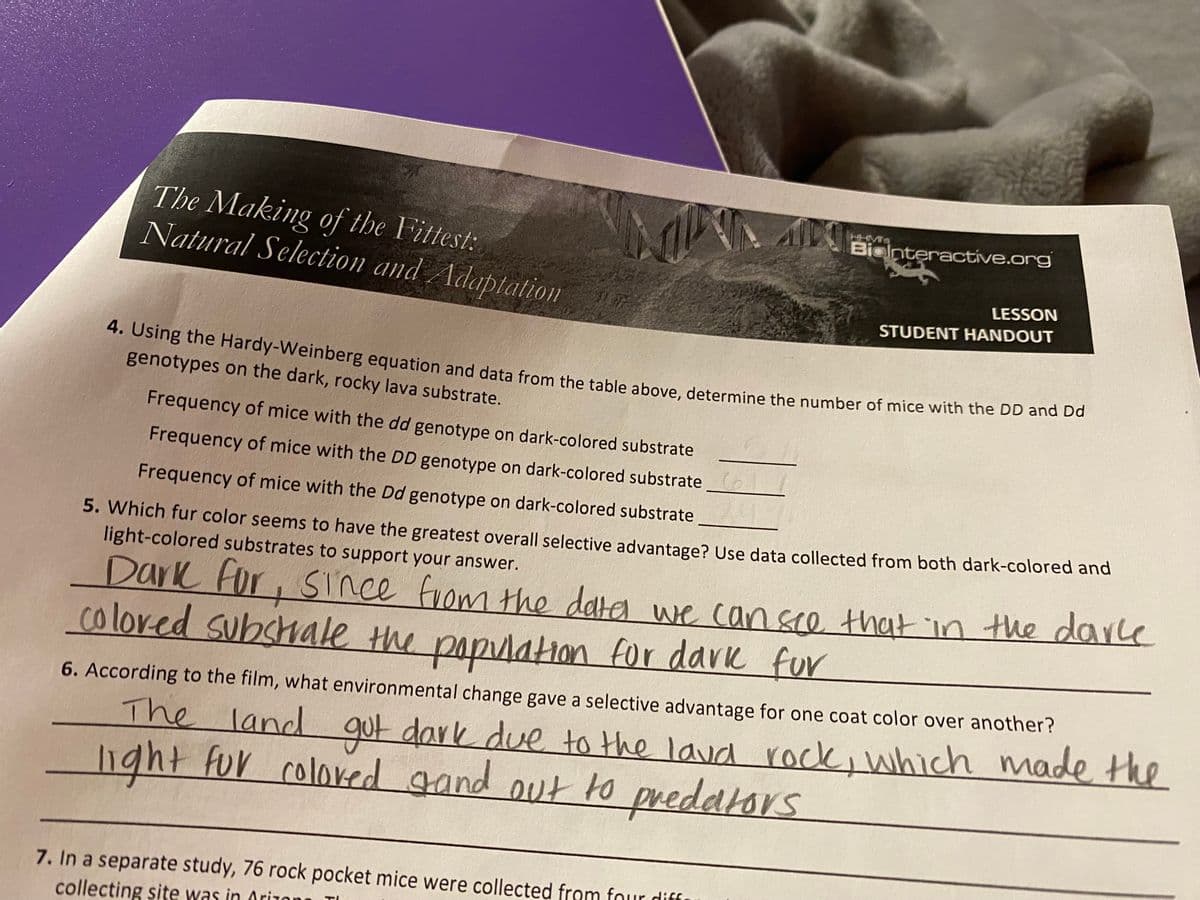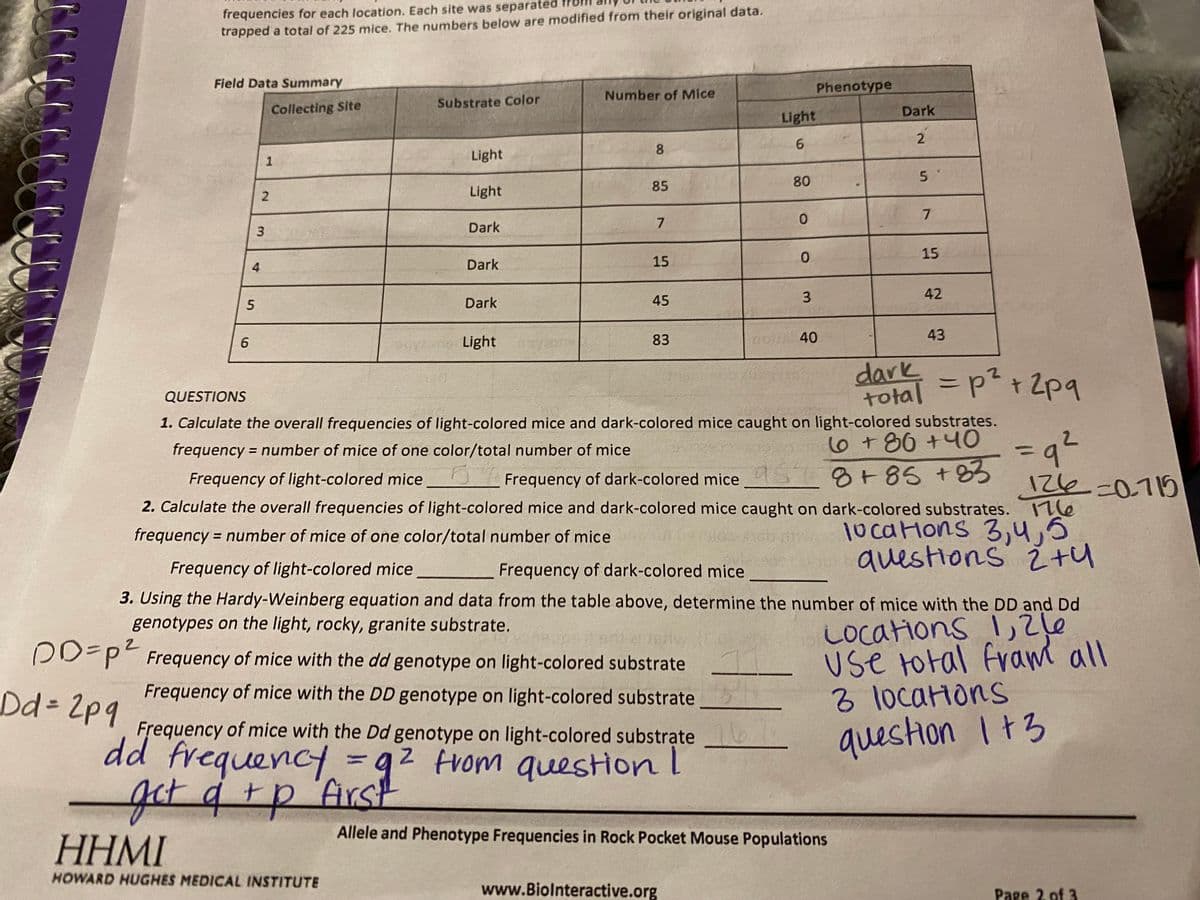Field Data Summary 29 6 4 5 dd 3 Collecting Site 1 2 Substrate Color Light Light Dark Dark Dark Allele and Di Light Number of Mice 8 85 7 15 45 83 2 =p² Frequency of mice with the dd genotype on light-colored substrate Frequency of mice with the DD genotype on light-colored substrate Frequency of mice with the Dd genotype on light-colored substrate frequency get a + p first = 9² Light 6 12 from question l 80 0 0 3 Phenotype 40 Dark 2 57 QUESTIONS 1. Calculate the overall frequencies of light-colored mice and dark-colored mice caught on light-colored substrates. frequency = number of mice of one color/total number of mice 6 +86 +40 8+85+83 Frequency of light-colored mice Frequency of dark-colored mice 126=0 2. Calculate the overall frequencies of light-colored mice and dark-colored mice caught on dark-colored substrates. 176 frequency = number of mice of one color/total number of mice locations 3,4,5 questions 2+4 15 42 Frequency of light-colored mice Frequency of dark-colored mice 3. Using the Hardy-Weinberg equation and data from the table above, determine the number of mice with the DD and Dd genotypes on the light, rocky, granite substrate. Locations 1,216 Use total fram all 3 locations question 1+3 43 dark total = p²+2pq =9² =
Field Data Summary 29 6 4 5 dd 3 Collecting Site 1 2 Substrate Color Light Light Dark Dark Dark Allele and Di Light Number of Mice 8 85 7 15 45 83 2 =p² Frequency of mice with the dd genotype on light-colored substrate Frequency of mice with the DD genotype on light-colored substrate Frequency of mice with the Dd genotype on light-colored substrate frequency get a + p first = 9² Light 6 12 from question l 80 0 0 3 Phenotype 40 Dark 2 57 QUESTIONS 1. Calculate the overall frequencies of light-colored mice and dark-colored mice caught on light-colored substrates. frequency = number of mice of one color/total number of mice 6 +86 +40 8+85+83 Frequency of light-colored mice Frequency of dark-colored mice 126=0 2. Calculate the overall frequencies of light-colored mice and dark-colored mice caught on dark-colored substrates. 176 frequency = number of mice of one color/total number of mice locations 3,4,5 questions 2+4 15 42 Frequency of light-colored mice Frequency of dark-colored mice 3. Using the Hardy-Weinberg equation and data from the table above, determine the number of mice with the DD and Dd genotypes on the light, rocky, granite substrate. Locations 1,216 Use total fram all 3 locations question 1+3 43 dark total = p²+2pq =9² =
Biology Today and Tomorrow without Physiology (MindTap Course List)
5th Edition
ISBN:9781305117396
Author:Cecie Starr, Christine Evers, Lisa Starr
Publisher:Cecie Starr, Christine Evers, Lisa Starr
Chapter10: Biotechnology
Section: Chapter Questions
Problem 1FIO
Related questions
Question

Transcribed Image Text:The Making of the Fittest:
Natural Selection and Adaptation
Frequency of mice with the dd genotype on dark-colored substrate
Frequency of mice with the DD genotype on dark-colored substrate
4. Using the Hardy-Weinberg equation and data from the table above, determine the number of mice with the DD and Dd
genotypes on the dark, rocky lava substrate.
AID
The land
land
Biolnteractive.org
Frequency of mice with the Dd genotype on dark-colored substrate
5. Which fur color seems to have the greatest overall selective advantage? Use data collected from both dark-colored and
light-colored substrates to support your answer.
Dark for, since from the datel we can see that in the darke
colored substrate the population for dark for
7. In a separate study, 76 rock pocket mice were collected from four diff
collecting site was in Arizona
LESSON
STUDENT HANDOUT
6. According to the film, what environmental change gave a selective advantage for one coat color over another?
gut dark due to the lavd rock, which made the
light for colored gand out to predators
PTI

Transcribed Image Text:frequencies for each location. Each site was separated
trapped a total of 225 mice. The numbers below are modified from their original data.
Field Data Summary
5
6
4
3
2
Collecting Site
1
Substrate Color
Light
Light
Dark
Dark
Dark
Light
Number of Mice
8
85
7
15
45
83
Frequency of mice with the DD genotype on light-colored substrate 511
Frequency of mice with the Dd genotype on light-colored substrate
dd frequency = 9² from question
2 I
get af + p first
HHMI
HOWARD HUGHES MEDICAL INSTITUTE
Light
6
80
0
www.Biolnteractive.org
0
Phenotype
3
to 40
Dark
2
Allele and Phenotype Frequencies in Rock Pocket Mouse Populations
5
7
15
QUESTIONS
1. Calculate the overall frequencies of light-colored mice and dark-colored mice caught on light-colored substrates.
frequency = number of mice of one color/total number of mice
gavam o +80 +40
8+85 +83
Frequency of light-colored mice
Frequency of dark-colored mice
2. Calculate the overall frequencies of light-colored mice and dark-colored mice caught on dark-colored substrates. 116
frequency = number of mice of one color/total number of mice
locations 3,4,5
questions 2 +4
42
43
Frequency of light-colored mice
Frequency of dark-colored mice
3. Using the Hardy-Weinberg equation and data from the table above, determine the number of mice with the DD and Dd
genotypes on the light, rocky, granite substrate.
957-20
DD=p² Frequency of mice with the dd genotype on light-colored substrate
Locations 1,266
use total fram all
3 locations
Dd=2pq
question 1+3
dark
=p²+2pq
total = p²+
=9²
126=0.115
ماح را
Page 2 of 3
Expert Solution
This question has been solved!
Explore an expertly crafted, step-by-step solution for a thorough understanding of key concepts.
This is a popular solution!
Trending now
This is a popular solution!
Step by step
Solved in 5 steps

Knowledge Booster
Learn more about
Need a deep-dive on the concept behind this application? Look no further. Learn more about this topic, biology and related others by exploring similar questions and additional content below.Recommended textbooks for you

Biology Today and Tomorrow without Physiology (Mi…
Biology
ISBN:
9781305117396
Author:
Cecie Starr, Christine Evers, Lisa Starr
Publisher:
Cengage Learning



Biology Today and Tomorrow without Physiology (Mi…
Biology
ISBN:
9781305117396
Author:
Cecie Starr, Christine Evers, Lisa Starr
Publisher:
Cengage Learning

